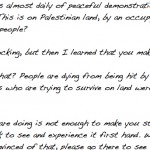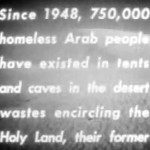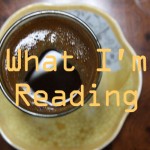
Published in The Nation
Christopher Hayes | October 14, 2010
Hebron
The first thing you notice when you drive into Hebron is the lack of cars. Since 1997 this second-largest Palestinian city in the West Bank, the only one with an Israeli settlement in its midst, has been formally divided. Within the Israeli section, which takes up much of the historic downtown, Palestinians are not allowed to drive, so they walk or use donkey carts. When people are ill or injured, they are carried to the hospital. It is not surprising, therefore, that many of the 30,000 Palestinians who once lived here have moved out. According to a 2007 report from Israeli human rights organizations, more than 1,000 Palestinian housing units in the area have been left vacant, and more than 75 percent of the businesses in the central district have closed. A handful of shops remain open; a cluster or two of children play in the street. But that’s it. The streets are buried under the heaviness of an ominous quiet. Periodically, buses rumble past bringing settlers to and from the adjoining settlement, Kiryat Arba, and Israel proper. In the absence of routine urban noise, their engines sound like gunshots.
I went to Israel and the West Bank with a group of American journalists on a trip sponsored by the New America Foundation. We were led through the streets of Hebron by Mikhael Manekin, a former Israel Defense Forces soldier who patrolled the city during the second intifada. He now runs an organization called Breaking the Silence, which collects testimony about IDF human rights abuses from Israeli soldiers. I had heard of Hebron, of course, but it was lodged vaguely in my mind as one of those foreign places where awful things happen. To see it in person is to understand viscerally that the status quo in the West Bank cannot hold. To see it is to understand just what occupation requires.
Because of the Cave of the Patriarchs—where Abraham is said to have buried his wife and was later laid to rest—Hebron is a very holy site for Jews and Muslims. Hebron’s long history has been one of occupation and coexistence, punctuated by periods of slaughter. Romans, Crusaders and Ottomans have all ruled the city, sometimes denying access to the holy sites to disfavored groups. In 1929 Arab rioters killed sixty-seven of the small number of Jewish residents of the city (several hundred were saved by their Arab neighbors, who hid them in their homes), and the last Jewish resident left the city in 1948. In 1968, just a year after Israel occupied Hebron, Rabbi Moshe Levinger, a spiritual founder of the settler movement, traveled with a few students to the city for Passover. Once there, they refused to leave, extracting a concession from the Labor government at the time to settle them in the adjacent army base of Kiryat Arba, which today is a settlement of 7,200.
In 1979 ten women and forty children from Kiryat Arba sneaked into the abandoned Jewish hospital in downtown Hebron under cover of night and also refused to leave. Over the next fifteen years, they were joined by hundreds of other settlers—men, women and children—drawn from the most zealous, who came to inhabit the surrounding buildings.
Over the past three decades, violence has been a mainstay. In 1980 Palestinians killed six yeshiva students in the city center. In 1988 Levinger shot and killed a Palestinian store owner, pleaded guilty to negligent homicide and served thirteen weeks in prison. In 1994 Baruch Goldstein, from Kiryat Arba, entered the mosque at the Cave of the Patriarchs and murdered twenty-nine Muslim worshipers before he was overcome and killed. The IDF imposed near total curfews on area Palestinians.
Then, in 1997, as part of the Oslo peace process, security control over Hebron was divided. Palestinian Hebron, now home to some 170,000, fell under the jurisdiction of the Palestinian Authority and became known as H1. The section dominated by Israeli settlers remained under IDF control and became known as H2. There are 800 Israeli citizens who live in H2, with 500 IDF soldiers to guard them.
Within its jurisdiction, the IDF enforces a policy it calls “separation,” which has a renewed urgency in the wake of the second intifada. A three-foot concrete barrier runs down the main street of the downtown, creating a small shoulder where Palestinians may walk; Israelis pass on the other side. A few blocks farther on, an Israeli soldier and a flag on a rooftop herald the beginning of the zone the army calls “fully sterilized,” meaning no Palestinians. A young merchant hawking bracelets followed our group, entreating us to buy a souvenir. He stopped short, as if running into a glass wall, the moment we hit the outpost.
It felt as if we were walking through a postapocalyptic urban video game brought to life. The old Hebron gold market sat empty and trashed, every shop door was shuttered, graffiti was scrawled over much of the area. Eight Israeli soldiers with flak jackets and machine guns marched slowly past in formation, making their regular patrol through the deserted streets. A police car began to tail us, since Mikhael has been assaulted by settlers while leading people through the neighborhood.
In the courtyard outside the main settlers’ apartment complex, a group of boys played soccer in a lot sandwiched between a large recycling bin half full of plastic bottles and a sign that read, in part: This land was stolen by arabs following the murder of 67 hebron jews in 1929. We demand justice! Return our property to us! Women in head wraps and long skirts pushed strollers; men walked past with shopping bags. Though they live inside a heavily militarized garrison, they can walk the empty streets as if in a European pedestrian mall.
Around the corner, on Shuhada Street, are the last Palestinian holdouts in the neighborhood. They occupy second-floor apartments with balconies covered in metal braces and chicken wire. Because the street is closed to Palestinians, the residents of these caged apartments are not allowed to use their front doors; at those rare times when they leave to get provisions they must go out via the roof or makeshift doors.
As we reached the limits of H2, past graffiti of Stars of David and the slogan For every settlement evacuated, we will kill 100 Arabs, we arrived at an Israeli checkpoint, a small wooden shack manned by a few soldiers. Mikhael told us that as an Israeli, he couldn’t go through but urged us to do so. As if passing through a magic portal, we emerged on the other side into the honking, bustling chaos of a living city: shops selling T-shirts and DVDs, shopkeepers smoking cigarettes and shouting to one another over the noise, commuters hailing cabs and pedestrians dodging snarled traffic. And then, back through the magic door and into the deathly silence of occupied Hebron.
There, while settlers routinely harass Palestinian residents and the tension sometimes erupts into violence, the IDF has succeeded in its immediate goal of avoiding large-scale bloodshed. This has come, however, at the cost of turning a holy city into a moral obscenity. One might be tempted to dismiss Hebron as unique, but Mikhael insists it’s only a matter of degree rather than kind. “This is the same policy all over the West Bank,” he says. “Separation, militarization, patrol roads. In rural areas it looks a lot nicer, but it’s no different.”
At a lunch earlier that day, a prominent member of the Yesha Council, the organizing body for the settler movement, told us his “conscience is clear” about Israeli settlement and the occupation of the West Bank. But after the tour of Hebron, our bus driver, who hadn’t been to the West Bank since serving there in the 1967 war, looked at us as we boarded the bus and said, “As an Israeli, I am shocked.”
Before long, Israelis may not have to travel to Hebron to see what full-spectrum urban occupation looks like. In recent years, the most ideological of the settler organizations have, with government help, stepped up efforts to “Judaize” East Jerusalem, to make it far more difficult to incorporate into a Palestinian state, should that day arrive.
Things are especially tense in the East Jerusalem neighborhood of Silwan, where settlers have purchased apartment complexes and number about 500, dotted among 60,000 Palestinians. In September a private Israeli security guard shot and killed a Palestinian father of five named Samer Sirhan. The guard claimed he was faced with a life-threatening ambush from which he had to shoot his way out, but witnesses and security camera footage contradicted his account. The police accepted the guard’s version, and no charges were filed. Since then there’s been an escalation of rock-throwing at the settlers, and settlers have called for a heavier police presence and more security. On the day we toured East Jerusalem, the head of the Silwan settlers, David Be’eri, ran over two Palestinian boys after his car was targeted by rock-throwers. Many people told us that if there is a third intifada, it will start in Silwan.
In the East Jerusalem neighborhood of Sheikh Jarrah, another settler group has used a few Ottoman-era land deeds and the power of the state to evict fifty-three Palestinians from their homes—which their families had moved to after being expelled in 1948 from their original homes in present-day Israel. The evictions have been denounced by everyone from Hillary Clinton to Israeli author David Grossman and have sparked a weekly protest that every Friday draws many Israelis to the only municipal park in East Jerusalem. But so far, despite legal appeals, the settlers remain in the houses.
There is a pointed irony in the settlers using pre-1948 deeds to make their case for occupying the homes in Sheikh Jarrah: it is usually Palestinians, demanding their right of return, who argue that pre-1948 deeds are legitimate. “From a Zionist perspective, it’s suicide,” activist and writer Didi Remez says about these settlers. “What they’re trying to do is bring Hebron to Jerusalem.” God help us if they succeed.
